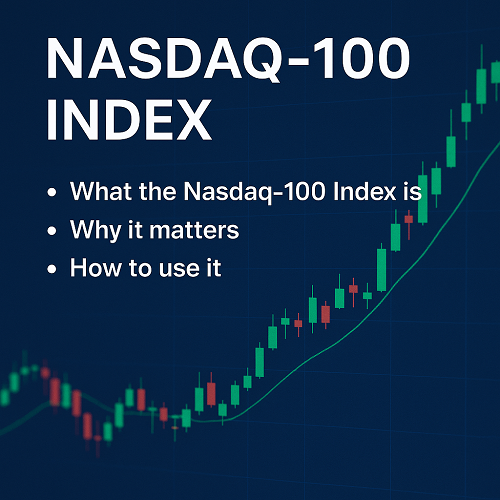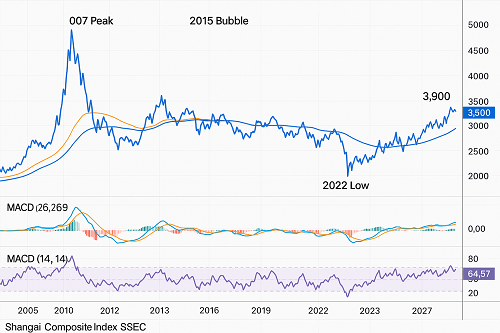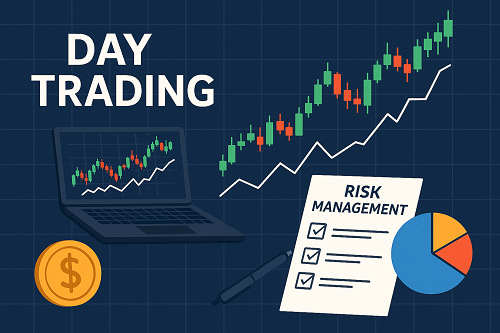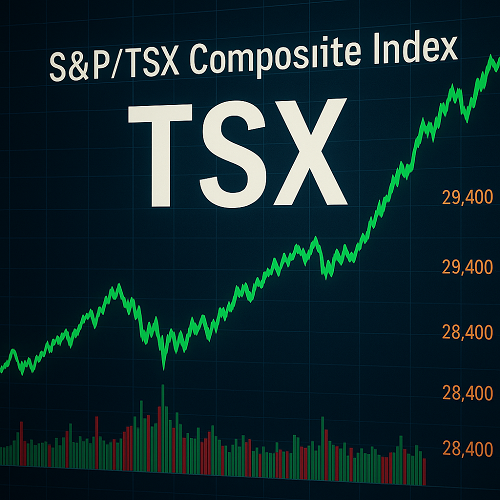Why the Nasdaq-100 Index Is a Benchmark for the 21st Century
The Nasdaq‑100 Index (ticker symbol NDX) is one of the world’s most watched large-cap, non-financial market benchmarks. Composed of 100 of the largest domestic and international non-financial companies listed on the Nasdaq, Inc. stock market (by market-capitalization), it serves as a proxy for innovation-led growth in sectors such as technology, consumer, healthcare and industrials.
For traders, investors and asset managers alike, the Nasdaq-100 offers both opportunity and challenge: high growth potential combined with unique risk exposures. Understanding how it is constructed, its performance drivers, and how to access it is essential for modern portfolio management, trading strategy and index-product innovation.
Definition & Key Features
What exactly is the Nasdaq-100 Index?
- The Index tracks 100 of the largest non-financial companies listed on the Nasdaq Stock Market, selected and weighted by market capitalisation.
- It excludes financial companies (banks, insurance, brokerage) in order to emphasise sectors at the forefront of innovation.
- The Index is rebalanced and reviewed periodically (typically quarterly) so that it remains representative of the leading companies in each sector.
- It is primarily market-cap weighted, meaning larger companies exert greater influence on the Index’s performance.
Key characteristics that differentiate it
Here are the standout traits of the Nasdaq-100 Index:
- Exclusion of financials → By excluding banks and traditional finance, the index zeros in on “new economy” sectors such as cloud, semiconductors, biotech, e-commerce.
- Broad sector representation → Although technology dominates, meaningful exposures exist in consumer discretionary, healthcare, industrials and communications services.
- Global reach → While listed on Nasdaq, several index constituents are non-U.S. companies, giving international flavour and growth exposure.
- Dynamic & adaptive → Regular rebalancing and methodology updates ensure the index remains current with market leaders, not static legacy names.
- Benchmark for growth → The Nasdaq-100 has built a long track record of out-performance relative to many broader large-cap benchmarks.
How the index works (methodology summary)
While the full methodology is more detailed, here’s a simplified breakdown:
- Companies eligible are listed on the Nasdaq Stock Market and have the requisite size, liquidity and non-financial status.
- Market-capitalisation weighting means companies with higher free-float market caps carry more weight.
- There is typically a review and rebalancing process (e.g., quarterly) to adjust for corporate actions, eligibility changes, and to keep the index aligned with its innovation-growth objective.
- An equal-weighted variant also exists (e.g., Nasdaq-100 Equal Weighted™) to reduce concentration risk and provide alternative exposure.
Why the Nasdaq-100 Index Matters
Growth exposure in one index
In an era defined by rapid technological change, digital transformation and global competition, the Nasdaq-100 offers a concentrated and focused means of accessing leading growth companies. For investors seeking exposure to “innovators” rather than purely broad market coverage, the index is a go-to choice.
Portfolio diversification & strategic positioning
Putting some allocation to the Nasdaq-100 can serve several portfolio roles:
- Core growth allocation: For growth-oriented investors, it provides large-cap exposure to high-quality companies.
- Innovation tilt: It gives portfolios a “tilt” toward sectors and companies that may grow faster than the broad market.
- Benchmarking: Many asset managers use the index as a reference point for growth-oriented products (ETFs, funds, annuities).
- Trading & hedging: For traders, the index and its derivatives (futures, options) offer high-liquidity tools for expressing views on tech/growth sectors.
Performance history & out-performance claims
Over multiple cycles, the Nasdaq-100 (driven by its heavy tech/digital bias) has out-performed many traditional large-cap indices (such as the S&P 500) in bull markets, albeit with elevated risk in corrections. For example, large-cap technology rallies have often driven the index’s gains.
However, this out-performance comes with higher volatility and sector concentration risk — things investors and traders must understand and manage.
Role for different market participants
- Asset managers: Use the index as a foundation for active or passive growth funds; can licence the index to build ETFs or structured products.
- Asset owners (pension funds, endowments): Leverage it for growth allocations, innovation exposure, and benchmark performance evaluation.
- Financial advisors: Use the index in constructing client portfolios, particularly for clients seeking large-cap growth or innovation exposure.
- Insurance companies: Build index-linked annuities or structured products referencing the Nasdaq-100, leveraging its brand and innovation appeal.
Constituents & Sector Breakdown
Who’s in the index?
While the full list of 100 constituents changes over time, the key takeaway is: the Nasdaq-100 is dominated by large technology growth companies. Some of the largest weights typically include top-tier names in cloud computing, semiconductors, software, internet services, consumer tech hardware.
As of the latest rebalancing, the top holdings may include (note this list is illustrative):
- Apple Inc. (AAPL)
- Microsoft Corporation (MSFT)
- Amazon.com, Inc. (AMZN)
- Alphabet Inc. (GOOGL/GOOG)
- NVIDIA Corporation (NVDA)
- Meta Platforms, Inc. (META)
Sector weights & concentration
The index typically features large weights in:
- Information Technology & Software
- Consumer Discretionary (especially internet-retail and services)
- Communications Services
- Healthcare (selected names)
- Industrials / Consumer products (but to a lesser extent)
Given its structure, there is sector concentration risk (especially in large tech names) — something investors need to consider.
Geographic and global tilt
Although the companies are listed on Nasdaq, many have global operations, and some are non-U.S. domiciled firms. This gives the index a measure of international exposure, albeit indirectly.
Equal-weighted variant option
For those concerned about heavy concentration in mega-cap names, the equivalent equal-weight version (such as the Nasdaq‑100 Equal Weighted Index) spreads weight more evenly across all 100 companies — reducing single-company risk and perhaps improving diversification.
How to Invest or Trade the Nasdaq-100 Index
Via ETFs and index funds
The most common access point for investors is through exchange-traded funds (ETFs) that track the Nasdaq-100. Some popular examples:
- Invesco QQQ Trust (ticker: QQQ) — tracks the Nasdaq-100.
- Other global equivalents (outside the U.S.) may track the index or variants.
Advantages of using ETFs: high liquidity, transparency, ease of access, cost efficiency in many cases.
Via futures & derivatives
For more advanced traders, the Nasdaq-100 futures contract (often ticker NQ) and options provide leveraged exposure, hedging ability, and active trading performance. This is ideal for expressing views on large-cap growth sectors, hedging portfolios, or managing tactical exposure.
Via structured products and index licences
Asset managers or institutions can licence the index (or a variant) to build structured products, derivatives or custom portfolios. This is particularly relevant for product innovation, annuities, or quant strategies focusing on the Nasdaq-100 universe.
Strategy considerations for investors/traders
- Long-term buy & hold: Investors seeking growth may allocate a core portion of their portfolio to the Nasdaq-100 via an ETF and hold for multiple years.
- Tactical overlay: Traders might use futures/options to tactically tilt toward or away from the Nasdaq-100 based on macro or sector themes.
- Hedging: Portfolio managers with large caps in other sectors may hedge using Nasdaq-100 derivatives when they expect tech/growth sectors to under-perform.
- Risk management: Given its concentration, it is wise to consider position size, stop-loss rules, and diversification around the Nasdaq-100 allocation.
Risks & Considerations
Concentration risk & sector bias
The Nasdaq-100’s heavy tilt toward technology and growth means that when the tech sector is under pressure (e.g., rising interest rates, regulatory challenges, semiconductor supply issues), the index can under-perform significantly.
Volatility
High growth companies often have more volatile earnings forecasts and valuations. The Nasdaq-100 therefore may experience sharp drawdowns in market corrections.
Valuation risk
When valuations are elevated (as often is the case for growth stocks), the potential for corrections increases. Investors must weigh growth potential against valuation-based risk.
Macro and regulatory impacts
Given the global nature of many constituents, the index is susceptible to global macro shocks (e.g., supply-chain disruptions, geopolitical tensions) and regulatory risks (e.g., antitrust actions, data/privacy regulation) especially for tech and internet companies.
Liquidity and tracking risk (for non-ETF access)
For some products or derivatives referencing the Nasdaq-100, there may be tracking error, product cost, roll-costs (in futures) or lesser liquidity — each of which can act as a stealth drag on returns if not properly understood.
Historical Performance & What It Tells Us
Long-term return profile
Over the past decade, the Nasdaq-100 has delivered strong cumulative returns driven by major technology winners. Investors who held the index through full market cycles often benefited from the rapid expansion of cloud, semiconductors, software and digital platforms.
Performance in bear markets
However, during market downturns, the index can correct sharply. For example, in periods of rising interest rates or tech-sector sell-offs, growth stocks (which dominate the index) typically under-perform. Understanding this drawdown potential is crucial.
Comparing to other indices
Compared with broader benchmarks (such as the S&P 500), the Nasdaq-100 has often out-paced in bullish phases, but also lagged or fallen harder in corrections. Thus, investors should consider it as part of a diversified mix rather than an all-in bet.
Lessons from past cycles
- Market leadership shifts matter: Some companies that led earlier cycles may no longer be in the top weights, so periodic review or rebalancing is worthwhile.
- Innovation drives long-term outperformance, but novelty risks apply: high-growth companies may face disruption themselves.
- Valuation discipline and risk control make a difference: Investors who ignored valuation risks or held through corrections without hedging sometimes suffered larger losses.
Advanced Insights & Trading Strategies
Thematic tilts within Nasdaq-100
Even within the index, different sub-themes can be identified: cloud computing, AI/ML, semiconductors, internet platforms, biotech and consumer technology. A savvy investor/trader can:
- Monitor which themes are gaining edge (e.g., acceleration in AI spending).
- Use sector/industry weight shifts as signals (e.g., when semiconductors rise within the index, that may indicate a hardware growth phase).
- Overlay derivative positions (futures/options) to express tactical tilts, e.g., bullish on semiconductors but hedged on internet services.
Seasonality and macro influences
- Interest-rate changes: Growth stocks (and the Nasdaq-100) are negatively impacted by rising rates (which discount future earnings).
- Inflation and corporate margins: Technology and internet companies can benefit from scale, but inflation may compress margins or increase input costs.
- Geopolitical/tech supply chains: Semiconductors and cloud compute companies often have global supply chains and may be vulnerable to geopolitical risk, trade policies or supply-chain disruptions.
- Market breadth & concentration: When the top handful of companies drive the index, breadth is narrow; this indicates market fragility.
Risk management techniques
- Use options to hedge large positions in Nasdaq-100 ETFs or futures (e.g., buying put options, collar strategies).
- Apply stop-loss or trailing stop rules on derivatives.
- Diversify by supplementing Nasdaq-100 exposure with broader indices (S&P 500, Russell 2000) or sectors outside technology.
- Consider equal-weight variants to reduce single-stock concentration risk.
Portfolio rebalancing & exposure control
- Review exposure periodically (semi-annually or quarterly) to ensure the Nasdaq-100 allocation still aligns with risk tolerance and objectives.
- Avoid letting the allocation creep too high in a recovery-driven market.
- Consider gradually trimming if valuations get extended, or increasing hedges when tech leadership becomes extreme.
Investing vs Trading: Choosing Your Approach
Investor mindset
If your goal is long-term growth:
- Use a low-cost ETF tracking the Nasdaq-100.
- Focus on dollar-cost averaging rather than timing.
- Accept higher volatility for higher long-term upside (assuming you’re comfortable).
- Ensure the allocation to Nasdaq-100 is appropriate relative to your overall portfolio (considering diversification).
Trader mindset
If you approach it from a trading/horizon perspective:
- Use futures (NQ) or options on the Nasdaq-100 or ETFs to express directional views.
- Focus on macro triggers or technical signals (trend breaks, volume surges, sector rotation).
- Employ risk controls: position size limits, stop-loss orders, hedging.
- Monitor correlation with other assets (e.g., S&P 500, Russell 2000) to gauge whether the Nasdaq-100 is leading or lagging.
Hybrid approach
Many participants adopt a hybrid: core long exposure via an ETF, plus tactical overlays via options or futures to hedge or amplify views. This offers flexibility while maintaining long-term exposure.
How to Use This Guide in Your Strategy
For Portfolio Construction
- Decide on target allocation: e.g., “I want 15% of my equity portfolio in large-cap innovation, via Nasdaq-100.”
- Choose entry method (ETF, index fund) and rebalance annually or semi-annually.
- Monitor valuations: when the price-to-earnings or price-to-sales of the largest constituents become elevated relative to history, consider reducing weight or hedging.
For Trading/Active Management
- Establish a trade plan: use technicals (moving averages, breakouts), sector rotation signals, macro catalysts (interest rate decisions, earnings cycles).
- Combine derivative strategies: for example, buy call spreads on Nasdaq-100 futures when bullish, or buy protective put options when expecting risk-off.
- Track risk: maximum drawdown, correlation with broad market, implied volatility in Nasdaq-100 options.
- Review performance and adjust strategy: e.g., if tech leadership is fading, shift to other indexes or equal-weight variants.
For Product Development (Asset Managers, Advisors)
- Use Nasdaq-100 licensing (if available) to build an ETF, structured product or index-linked annuity.
- Leverage the “innovation” narrative tied to the Nasdaq-100: many investors believe they’re investing in future winners.
- Provide educational materials to clients: explain the index’s methodology, concentration risks, and role within larger portfolios.
FAQs
Q1. How does the Nasdaq-100 differ from the S&P 500?
The Nasdaq-100 excludes financial firms, focuses heavily on technology and innovative companies, and tends to have a narrower, more concentrated sector bias compared with the diversified S&P 500.
Q2. Is investing in the Nasdaq-100 risky?
Yes, there are heightened risks due to sector concentration (especially tech), valuations, and sensitivity to macro factors such as interest rates. It’s riskier than a broad-market index but offers higher growth potential.
Q3. Can I access the Nasdaq-100 outside the U.S.?
Yes—many global ETFs and investment funds replicate the Nasdaq-100 or variants. However, check expense ratios, tracking error, currency risk and tax implications.
Q4. What is the difference between the market-cap weighted and equal-weighted versions?
Market-cap weighting emphasizes the largest companies, meaning the top few names drive much of the index performance. Equal-weight distributes weight more evenly so each of the 100 companies contributes roughly equally — reducing concentration risk and altering the return profile.
Q5. When is the index rebalanced?
The index undergoes scheduled reviews (typically quarterly) to update eligibility, apply corporate actions, and ensure the index remains representative of the largest non-financial Nasdaq companies. Exact dates and methodology can be found in the official index methodology documentation.
Summary & Final Thoughts
The Nasdaq-100 Index stands as a premier benchmark for the innovation-and-growth segment of the market. For long-term investors, it provides exposure to large-cap growth companies that are at the frontier of technology, consumer services and digital transformation. For traders, it offers liquid, derivative-accessible opportunities to express views on sector leadership, rotation and macro catalysts.
However, with great opportunity comes heightened risk: concentration in mega-cap tech, sensitivity to interest rates and valuations, and potential for large drawdowns. Whether you approach via passive ETF, active trading or product development, being fully informed about how the index is built, how it behaves in different market regimes and how to manage its risks is essential.
By using this comprehensive guide as your roadmap, you’ll be better positioned to decide how, when, and why to deploy the Nasdaq-100 Index in your portfolio or trading strategy — and to do so with clarity, discipline and confidence.





 XAUT-USD
XAUT-USD  AMD
AMD  MARA
MARA  SHOP
SHOP  BULL
BULL  CL=F
CL=F